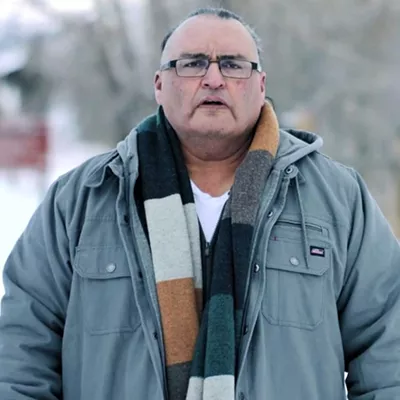José Galvez's career of paying homage to his heritage will place the Pulitzer Prize-winning photojournalist and his work at La Pilita Museum. This Sunday, he will be showing some of his black-and-white photographs and debuting Shine Boy, a book of photos and essays.
Galvez, 59, won a Pulitzer Prize for documenting Latino communities in Southern California while with the Los Angeles Times. He's currently working in North Carolina, where he is photographing the Latino community. Documenting the immigrants of that area is important to him, because it localizes a national debate, he said.
He's spent his life documenting Latino communities across the nation—but he started in Tucson. He was raised on South Main Avenue, two blocks from La Pilita Museum's current location. As a 10-year-old, he worked as a paperboy, selling newspapers on the streets of downtown. When the papers sold out or business ran dry for the day, Galvez would pull out his shoeshine box.
"Kids, boys, we could wander around and be adventuresome, be entrepreneurs, be hustlers," he said. "It was safer then."
Galvez started spending his time behind a service station, and he would occasionally shine the shoes of reporters. He made a name for himself; one fateful day, a sports reporter asked for "that little shoeshine boy" to come by the office, because he needed a good shine job.
He went to the then-downtown offices of the Arizona Daily Star, and it changed the course of his life.
"I opened the door and said, 'Wow. These are the people who write the stories that I sell. I want to be here one day,"' said Galvez.
He started going there every day. The reporters took him under their wing. He fetched coffee, pulled weeds and rushed documents to reporters, making tips all along. They'd tip a nickel, sometimes a dime, he said.
Photojournalist Jack Sheaffer started bringing him on assignments. He carried the camera bag—never the camera—but it didn't matter. Galvez said everybody knew Sheaffer's name, and everybody asked him to take their picture.
"I thought it was the coolest job," he said. "Here I was 11, 10 years old on the sidelines at the football game; I thought I must be pretty special."
He picked up a pawn-shop camera in high school and never stopped snapping. His first published photographs were a couple of class assignments that ran in the high school yearbook. Galvez eventually worked his way to a UA journalism degree and started photographing for the Star.
It wasn't until after graduating from high school that Galvez branched out from the photojournalistic style he had known. Inspired by the photo essays he found in magazines like Life, Look and The Saturday Evening Post, Galvez turned his lens toward his community—the barrio, he said.
"They aren't my family, but they are," Galvez said about the people in his photos from that time. "That old woman standing in the doorway—she isn't my grandmother, but she could be."
Before he was finished, he had documented a rich history. The "urban renewal" of the late 1960s wiped out a great deal of Galvez's stomping grounds. While much of the community was lost to gentrification and an attempt to change the city's image, his pictures remain.
"Some of the houses are still there," he said. "Little pieces."
Almost 40 years later, he and his work are coming back to Tucson, two blocks away from where he was raised. He wants to give that story to his community, he said; he wants the kids to know.
"This is your community, this is your barrio," he said.
Joan Daniels, development and education director at the museum, said La Pilita's mission is to preserve the history of the area. Galvez's storytelling does just that, she said.
"This is a wonderful opportunity for us," said Daniels.
The purpose of Galvez's book is to do the same. He said the essays in the book are "little things that help explain what drove me. They are just sort of a testimony to my family."
And, yes: An old-fashioned shoeshine kit will be included in the exhibit.







